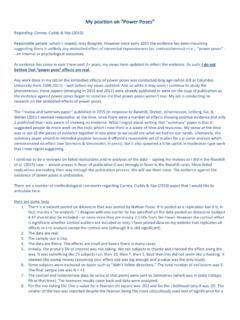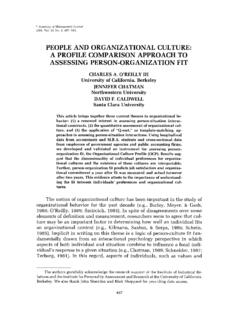Transcription of Implementing strategic change in a health care system: The ...
1 Implementing strategic change in ahealth care system : The importance ofleadership and change readinessDavid F. CaldwellJennifer ChatmanCharles A. O Reilly IIIM argaret OrmistonMargaret LapizBackground:Shifts in the environment can compel health care organizations to change their strategies. Howeverstrategic change frequently fails because individuals do not adopt the behaviors necessary to successfullyimplement the new :This study explores how three variables agreement with new strategy, leaders actions, and groups general orientation toward change can influence members of physician teams to take actions supporting astrategic shift aimed at improving patient :Physicians in 37 specialty departments in a large health care organization were surveyedregarding their support for a new customer service initiative, the actions of department leaders, and generalizednorms supporting change .
2 The results of the survey were linked to changes in patient satisfaction for :Normative support for the specific strategic change was directly related to increased patient satisfaction1 year later. The interaction between norms supporting change readiness and the quality of leadership waspositively related to change in patient Implications:Successfully Implementing a strategic change often requires getting individuals to changetheir behaviors. Leaders can enhance the results of the change by working to develop general norms such asteamwork and tolerance for mistakes that increase general readiness for change with the Lee and Alexander (1999) note, it is certainly not news that change rather thanstability is now the norm in health careorganizations and that the ability to change and adaptis critical for success.
3 Whether the change is in thestructure of an organization or the adoption of newprocedures or processes, summaries of research (Bazzoli,Dynan, Burns, & Yap, 2004; Fleuren, Wiefferink, &April June 2008124 health Care Manage Rev, 2008, 33(2), 124-133 CopyrightA2008 Wolters Kluwer health | Lippincott Williams & WilkinsDavid F. Caldwell, PhD,is Professor, Leavey School of Business, Santa Clara University, California. E-mail: Chatman, PhD,is Professor, Haas School of Business, University of California, A. O Reilly III, PhD,is Professor, Graduate School of Business, Stanford University, Ormiston, PhD,is Assistant Professor, London Business Lapiz, MPH, MBA,is Vice President and Regional Administrator, The Permanente Medical Group, Oakland, words: change readiness, health care, strategy implementationCopyright @ 2008 Lippincott Williams & Wilkins.)
4 Unauthorized reproduction of this article is , 2004; Greenhalgh, Robert, McFarlane, Bate,& Kyriakidou, 2004) suggest that change and innova-tion fail not because the new strategies or goals areinappropriate but rather because organizations areunable to successfully implement them. Capturing thegain from a new strategy or change in process is notsimply a function of reallocating resources, providingnew technology, or reorganizing units; effective organi-zational change generally requires that employees andwork groups shift the way they do things. In fact, ifemployees and work groups do not change their be-haviors, Implementing a new strategy is often impossible(Schneider, Brief, & Guzzo, 1996).
5 Much of the responsibility for Implementing changeswithin health care organizations is given to groups orteams. In their review of empirical studies of teams inhealth care organizations, Lemieux-Charles and McGuire(2006) point out the importance of teams in changeefforts and suggest that effective team dynamics are re-lated to team success. Despite the critical role that groupsplay in implementation, comparatively little research hasinvestigated how groups within organizations can eitherfacilitate or inhibit organizational attempts to implementnew ideas (Burningham & West, 1995). The purpose ofthis article is to explore how an important element ofteam dynamics, thespecificnorms that exist within agroup, may be related to successful outcomes of a strategicchange.
6 In particular, we examine how teams supportfor a new strategy and the existence of norms support-ing a general orientation toward change contribute toan organization s successful implementation of a newstrategic addition, in contrast to many of the studies reviewedby Lemieux-Charles and McGuire (2006), we also inves-tigate the role of team leaders in Implementing and HypothesesSupport for strategic ChangeWhat are the dynamics or processes within a team thatcould support the behavioral change necessary toimplement a new strategy? Although researchers haveseldom directly addressed this question, some recentevidence suggests factors that might influence a group sability to implement a new technology or strategy.
7 Forexample, Klein, Conn, and Sorra (2001) found that implementation climate, defined primarily as supportfor the specific change , was related to successful appli-cation of advanced computerized manufacturing tech-nology in manufacturing plants. Other studies haveshown that when members of a management team haveconsensus about the direction of the strategic change ,success in Implementing the change is more likely ( ,Markoczy, 2001). The focus of much of this research hasbeen on the extent to which individualsagree withtheproposed change . The general logic of this argument isthat when people support the new strategy or value itsoutcomes, Implementing the strategy will be moresuccessful than if the strategy has only limited with this previous research, we propose thatwhen an organization undertakes a strategic change :Hypothesis 1: Performance improvements will begreater in units in which members agree with thenature of the new strategy than in units in whichmembers do LeadershipIn addition to whether members of a unit support a newstrategic direction, there is strong evidence that themanager of the group or unit may influence the speedand effectiveness with which new processes can beimplemented.
8 Although senior leaders play a criticalrole in identifying and Implementing a new strategy( , House & Aditya, 1997; Thomas, 1988), middle-level managers within an organization may, throughtheir leadership of groups within the organization, eitherenhance or undermine the organization s ability toimplement a strategic change . For example, if managersdo not support a strategy because it runs counter to theirinterests, they may delay Implementing it or evensabotage the success of the new efforts (Guth &MacMillan, 1986). When middle managers are involvedin and committed to the strategy, success is more likely(Wooldridge & Floyd, 1990). Within a single firm, thechoices made by individual managers can influence thespeed with which units adopt practices supporting a newstrategy (Maritan & Brush, 2003).
9 This suggests thatunderstanding the extent to which the intangible factorswithin a group can support implementation will beinfluenced by the leader of the unit. Consistent withthis line of research, we propose that when an orga-nization undertakes a strategic change :Hypothesis 2: Performance improvements will begreater in units with leaders who effectively demon-strate support for the new strategy than in units withleaders who do for change ReadinessAlthough both logic and empirical evidence suggest thatthere is a positive relationship between people s supportfor a new strategy and the effectiveness of implemen-tation, a somewhat different question is whether orga-nizations or units vary in terms of their capabilities toimplement changes, regardless of whether they areImplementing strategic change in a Heath Care system .
10 The importance of leadership and change Readiness125 Copyright @ 2008 Lippincott Williams & Wilkins. Unauthorized reproduction of this article is supported or not. This approach assumes thatgroups or units may differ in their overall orientationtoward change or in the general skills and competenciesthey need to implement new processes. For example,Ray, Barney, and Muhanna (2004) describe how ageneral orientation within an organization, which theycall service climate, is related to strategic efforts toimprove customer service. The factors defining thisservice climate are not related to any specific newcustomer service process but rather to a general set ofbehavioral norms that exist within a define group norms as legitimate, socially sharedstandards against which the appropriateness of behaviorcan be evaluated (Birenbaum & Sagarin, 1976).


















